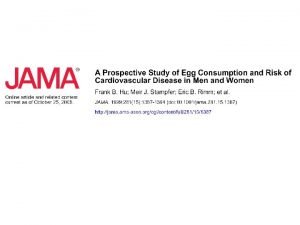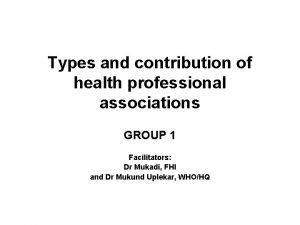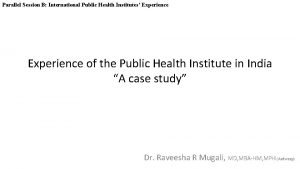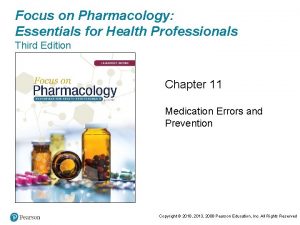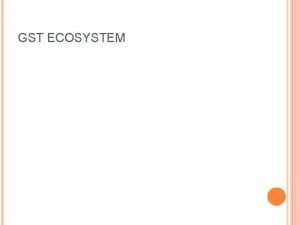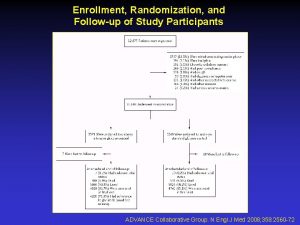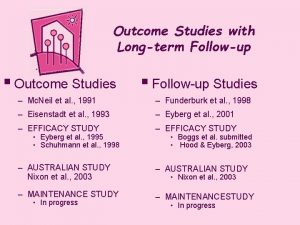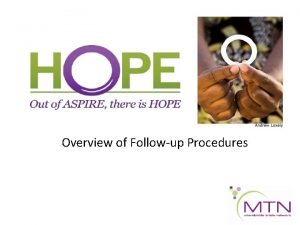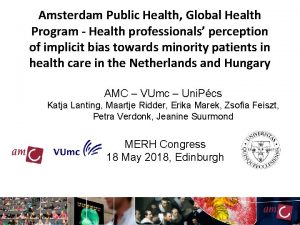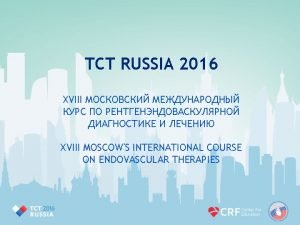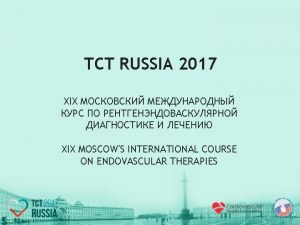Participants n The Health Professionals Followup Study HPFS























- Slides: 23



研究對象(Participants) n The Health Professionals Follow-up Study (HPFS) began in 1986 when 51, 529 men who were US health professionals (dentists, optometrists, pharmacists, podiatrists, and veterinarians), aged 40 to 75 years, answered a detailed questionnaire that included a comprehensive diet survey and items on lifestyle practice and medical history.

The Health Professionals Follow-up Study n n n Follow-up questionnaires were sent in 1988, 1990, 1992, and 1994 to update information on potential risk factors and to identify newly diagnosed cases of cardiovascular and other diseases. We excluded from the analysis men who did not satisfy the a priori criteria of reported daily energy intake between 3, 360 and 17, 640 k. J or who left blank more than 70 items of the 131 total food items in the diet questionnaire (n = 1, 152). We also excluded men with prior diagnoses of cardiovascular disease (n = 5, 182) or cancer (n = 1, 644) at baseline. In the primary analyses, we also excluded men who reported diabetes mellitus (n = 1, 187) or hypercholesterolemia (n = 4, 458) at baseline because these diagnoses could have led to changes in diet. Incidence of CHD and stroke during the subsequent 8 years was monitored for 37, 851 men during follow-up. The follow-up rate for nonfatal events was 97% of the total potential personyears of follow-up.

The Nurses’ Health Study n n n The Nurses’ Health Study (NHS) cohort was established in 1976 when 121, 700 women who were registered nurses residing in 11 large states, aged 30 to 55 years, provided detailed information about their medical history and lifestyle characteristics. Every 2 years, follow-up questionnaires have been sent to update information on potential risk factors and to identify newly diagnosed cases of CHD, stroke, and other diseases. In 1980, a 61 -item food frequency questionnaire was included to assess intake of specific fats and other nutrients. In 1984, the food frequency questionnaire was expanded to include 116 items. Similar questionnaires were used to update diet in 1986 and 1990. After up to 4 mailings, 98, 462 women returned the 1980 diet questionnaire. We excluded those who left 10 or more items blank, those with implausibly high or low scores for total food intake or energy intake (ie, < 2100 k. J/d or > 14, 700 k. J/d) (n = 5994), and those with previously diagnosed cancer (n = 3526), cardiovascular disease (n = 1812), high blood cholesterol (n = 1821), or diabetes (n = 4122) at baseline. Incidence of CHD and stroke during the subsequent 14 years was monitored for 80, 082 women during follow-up. The follow-up rate for nonfatal events was 98% of the total potential person-years of follow-up.

Assessment of Egg Consumption n Validated dietary questionnaires were sent to the HPFS participants in 1986 and 1990 and the NHS participants in 1980, 1984, 1986, and 1990. In all the questionnaires, we asked the participants how often, on average, during the previous year they had consumed eggs (unit of consumption was 1 egg). Nine responses were possible, ranging from never to 6 or more times per day. We divided the participants into 5 categories ( ≤ 1 per week, 2 -4 per week, 5 -6 per week, ≥ 1 per day) based on the frequency distribution of egg consumption. In a validation study in a subsample of the participants, the correlation coefficent between intakes of eggs assessed by the diet questionnaire and by multiple week diet records was 0. 8 for both men and women. We also computed intake of eggs included in other foods such as cakes, cookies, pancakes, muffins, sweet rolls, and donuts. The amount of eggs estimated from other foods was relatively small in both cohorts (men, 0. 4 egg per week; women, 0. 3 egg per week), so we used the reported egg consumption as our primary exposure variable. In a secondary analysis, we examined the effect of computed total egg consumption.

End Points n n n The end points were incident CHD (including nonfatal myocardial infarction [MI] and fatal CHD) and stroke occurring between return of the baseline questionnaires and January 31, 1994 (men), or June 1, 1994 (women). We inquired about occurrence of cardiovascular end points on each biennial questionnaire. Participants reporting an incident MI or stroke were asked for permission to review medical records. Nonfatal MI was confirmed by symptoms plus either typical electrocardiographic changes or increased activities in cardiac enzymes (World Health Organization criteria). Infarctions that required hospital admission and for which confirmatory information was obtained by interview or letter, but for which no medical records were available, were designated as probable. We included all confirmed and probable cases in the analyses because results were the same after excluding probable cases. Strokes were confirmed if characterized by a typical neurological defect of sudden or rapid onset, lasting at least 24 hours, and attributable to a cerebrovascular event. Strokes caused by infection or neoplasia were excluded. Strokes were subclassified according to the criteria of the National Survey of Stroke as due to ischemia (embolism or thrombosis), subarachnoid hemorrhage, intracerebral hemorrhage, or unknown cause. If no records could be obtained, strokes were considered probable if they required hospitalization and were corroborated by additional information provided by letter or interview.

統計方法 n Multivariate models included as covariates were (1) total energy intake (quintiles); (2) smoking (never, past, current 1 -14, 15 -24, and ≥ 25 cigarettes/d); (3) alcohol consumption (0 -4, 5 -9, 10 -14, 15 -29, and ≥ 30 g/d); (4) history of hypertension; (5) parental history of MI; (6) body mass index (calculated as weight in kilograms divided by the square of height in meters) (quintiles); and (7) current multivitamin use, and (8) vitamin E supplement use.

統計方法 n n n In HPFS, we also adjusted for physical activity in metabolic equivalents per week (quintiles). In NHS, we adjusted for regular vigorous exercise (once or more per week) and menopausal status and postmenopausal hormone use. Tests of linear trend across increasing categories of egg consumption were conducted by treating the median values of consumption in categories (servings per day) as a continuous variable.

統計方法 n n To reduce intra-individual variation and best represent long-term diet, we used repeated measures of diet in our primary analyses. In particular, CHD or stroke incidence was related to the cumulative average of egg consumption from all available questionnaires prior to the beginning of each 2 -year follow-up interval. For example, in HPFS, CHD or stroke incidence during the 1986 -1990 period was related to egg consumption assessed in 1986, while the incidence during 1990 -1994 period was related to the average intake assessed in 1986 and 1990.

統計方法 n n n For those who failed to complete the 1990 diet questionnaire (24%), we used the 1986 values to replace the missing values and a missing data indicator was included in the model to correct for potential bias. Average egg consumption at baseline was the same between the respondents and nonrespondents. In alternative analyses, we analyzed the incidence of CHD in relationship to egg consumption at baseline only.

統計方法 n n We also related the incidence to the most recent diet by using the baseline diet to predict incidence during 1986 -1990, and the 1990 diet to predict incidence during 1990 -1994. Because the diagnosis of hypercholesterolemia, diabetes, or hypertension may lead to changes in egg consumption and therefore confound the associations between egg consumption and risk of cardiovascular disease, we did not update diets for those who developed these conditions.



標準 n 吃蛋頻率分二大項 n n 1 per week, 2 -4 per week, 5 -6 per week, ≥ 1 per day 發病 n n Yes, No The relative risks (RRs) were calculated by dividing the incidence of CHD or stroke among men and women in various categories of egg consumption by the incidence among those in the lowest category of intake ( ≤ 1 egg per week), adjusting for age (5 -year categories).

研究對象(Participants) n A total of 37, 851 men aged 40 to 75 years at study outset and 80, 082 women aged 34 to 59 years at study outset, free of CHD, diabetes, hypercholesterolemia, or cancer.




結果 (Results) n n We documented 866 incident cases of CHD and 258 incident cases of stroke in men during 8 years of follow-up and 939 incident cases of CHD and 563 incident cases of stroke in women during 14 years of follow-up. After adjustment for age, smoking, and other potential CHD risk factors, we found no evidence of an overall significant association between egg consumption and risk of CHD or stroke in either men or women.

結果 (Results) n The relative risks (RRs) of CHD across categories of intake were less than 1 per week (1. 0), 1 per week (1. 06), 2 to 4 per week (1. 12), 5 to 6 per week (0. 90), and ≥ 1 per day (1. 08) (P for trend =. 75) for men; and less than 1 per week (1. 0), 1 per week (0. 82), 2 to 4 per week (0. 99), 5 to 6 per week (0. 95), and ≥ 1 per day (0. 82) (P for trend =. 95) for women.

結果 (Results) n In subgroup analyses, higher egg consumption appeared to be associated with increased risk of CHD only among diabetic subjects (RR of CHD comparing more than 1 egg per day with less than 1 egg per week among diabetic men, 2. 02 [95% confidence interval, 1. 05 -3. 87; P for trend =. 04], and among diabetic women, 1. 49 [0. 88 -2. 52; P for trend =. 008]).

結論 (Conclusions) n n These findings suggest that consumption of up to 1 egg per day is unlikely to have substantial overall impact on the risk of CHD or stroke among healthy men and women. The apparent increased risk of CHD associated with higher egg consumption among diabetic participants warrants further research.
 Followup edge
Followup edge Followup:actionitems
Followup:actionitems Followup visit
Followup visit Health professionals follow-up study
Health professionals follow-up study Types of health professionals
Types of health professionals Allied medical professionals list
Allied medical professionals list Allied health professionals
Allied health professionals What is waste management
What is waste management Hosa mission statement
Hosa mission statement Focus on pharmacology essentials for health professionals
Focus on pharmacology essentials for health professionals Lomotib
Lomotib Zimmerman telegram
Zimmerman telegram Pyramid
Pyramid Http://teachertech.rice.edu/participants/louviere/newton/
Http://teachertech.rice.edu/participants/louviere/newton/ Subject by subject counterbalancing
Subject by subject counterbalancing Financial markets and institutions jeff madura ppt
Financial markets and institutions jeff madura ppt Space shuttle discovery
Space shuttle discovery Introduction of participants in training
Introduction of participants in training Gst ecosystem diagram
Gst ecosystem diagram Carryover effects
Carryover effects Business buyer behavior
Business buyer behavior Participants in the business buying process
Participants in the business buying process Distribution channel of bmw
Distribution channel of bmw A model of business buyer behavior
A model of business buyer behavior



